The study sought to evaluate the indications, image quality, safety and impact on patient management of cardiac magnetic resonance imaging (CMR) in a district general hospital setting. The database was developed using retrospective analysis of patient records from the start of the local CMR service in January 2014 until January 2017. All 791 consecutive patients were included in the dataset.
The most important indications were the investigation of myocarditis/cardiomyopathies (54.5%), work-up of suspected coronary artery disease (CAD)/ischaemia (27.1%), and assessment of viability (9.1%). Image quality was diagnostic in 99.9% of cases. Mild adverse effects were reported for 3.8% of patients for stress CMR and in 1.1% of non-stress CMR. No serious adverse events were reported in this study population. In 26.5% of cases, CMR findings resulted in therapeutic modifications. In 18.1%, the final diagnosis based on CMR was different to that suspected before the CMR.
In conclusion, the findings of this study emphasise that CMR is a safe procedure with high image quality. In many cases, CMR can be shown to change a patient’s management plan.
Introduction
The European cardiovascular magnetic resonance (EuroCMR) registry1,2 was a multi-national, multi-centre report on the clinical use of cardiac magnetic resonance imaging (CMR) based on data up to 2012 including 27,000 patients. We have collected similar data on 791 consecutive patients based on the use of CMR in our local centre in Epsom, Surrey, UK, from the start of the service until the current time, encompassing a three-year period. This includes information on patient demographics, clinical safety, indications and impact on patient management. The aim of this study was to evaluate if the results of the multi-national European study were reflective of our experience of using CMR in a district general hospital (DGH) setting.
Methods
The data collection cohort included 791 consecutive CMR scans undertaken at the Clockhouse Centre in Epsom, Surrey, affiliated to Epsom and St. Helier Hospitals NHS Trust. Consecutive CMR reports from January 2014 (when the local service started) up to January 2017 were retrospectively analysed. Local health records were accessed to obtain data on more complex variables. As this was an observational study, no formal hypothesis testing was carried out. The odds ratio of complications and suboptimal image quality arising from CMR was calculated for different age groups to describe any association.3
Data were collected on a standardised proforma from written finalised reports regarding baseline patient characteristics, such as age and body mass index (BMI). Indications for CMR were assessed from the patient’s presenting history, which was recorded on the final CMR report under ‘patient background’. This was correlated with patient records, such as clinic letters, in order that the most relevant working diagnosis prior to the CMR was recorded as the indication for the study. The impact of the CMR on the patient’s management was then assessed by looking at the study conclusions and management plan section of the final CMR report, and correlated with the follow-up clinic assessment management plan, wherever possible. The most appropriate option was recorded, if applicable, for each patient who, following a CMR scan had a change in medication, went on to have an invasive procedure, or if the scan resulted in either hospital admission or discharge. These were the same variables of patient management assessed by the EuroCMR registry investigators. If the results of the CMR scan showed a completely new diagnosis, not suspected from the patient’s background and past medical history, this was also recorded.
It was locally agreed that a single therapeutic consequence would be recorded in each case, where appropriate. In cases where there were multiple therapeutic consequences, for example, a patient started on aspirin who is then referred for diagnostic angiography, the most significant outcome was recorded; in this case, the decision for angiogram. It is not clear how the EuroCMR investigators accounted for this group of patients. In the EuroCMR data, the figure for therapeutic consequences was conflated with the number of completely new diagnoses identified on CMR to give an overall percentage of patients for whom there was an ‘impact on management’, however, it is not clear from their methodology what should happen to the patients for whom there is a completely new diagnosis not suspected before, who then also undergo a therapeutic consequence, as this would run the risk of recording some patients multiple times. As such, the data are presented here separately for therapeutic consequences and for completely new diagnoses not suspected before.
Definitions of adverse events, for the purpose of the database, were predefined into mild and severe categories, applying the same categorisation as the EuroCMR registry, as far as possible. Dyspnoea, palpitations and chest pain not requiring medication or intervention, extra-systoles and allergic skin reactions with no systemic effects were recorded as mild adverse events. On the other hand, severe adverse events were defined as arrhythmias with the potential for haemodynamic compromise, such as ventricular tachycardia or ventricular fibrillation, acute coronary syndromes (ACS), heart failure or systemic allergic reactions, including anaphylaxis.
Diagnostic image quality was recorded for each scan by categorisation into good, moderate and poor following the terminology of the EuroCMR registry. These categories were locally agreed, as the precise definitions of image quality in the EuroCMR registry were not published. Good image quality denoted a scan with entirely optimal image acquisition. Moderate image quality denoted a scan with suboptimal image acquisition due to heart rate variability, arrhythmias, patient difficulties in breath-holding or some other procedural issue, but remained clear enough to render a final diagnosis and answer the clinical question. Poor image quality denoted a scan where insufficient images were taken to offer a final diagnosis.
All CMR reporting was performed by an experienced CMR physician (an imaging consultant cardiologist) with over 10 years’ experience of CMR reporting, who also supervised the data collection.
The data collection was carried out by two junior doctors working in the cardiology department of Epsom General Hospital.
The study methods were reviewed by the Epsom and St. Helier clinical governance committee, who are the body in our trust responsible for ethical approval of audit research projects. They have approved that our methods comply with the standards set out in the World Medical Association (WMA) declaration of Helsinki ethical principles for medical research involving human subjects.
Results
Baseline characteristics are shown in table 1: 57.1% of the scans were on male patients with a mean age of 61.0 years and an overall mean BMI of 28.1 kg/m2. Of all scans, nearly two-thirds were adenosine stress perfusion scans (65.6%) and, when broken down by age group, the majority of the scans for the ≤44 year age group were anatomical scans, whereas the older age groups tended to be referred for stress perfusion using adenosine in the vast majority (see data on file: Appendix A). The oldest patient was 96 years old and the heaviest patient was 170 kg with a BMI of 59 kg/m2. The magnet field used for all scans was 1.5 Tesla.

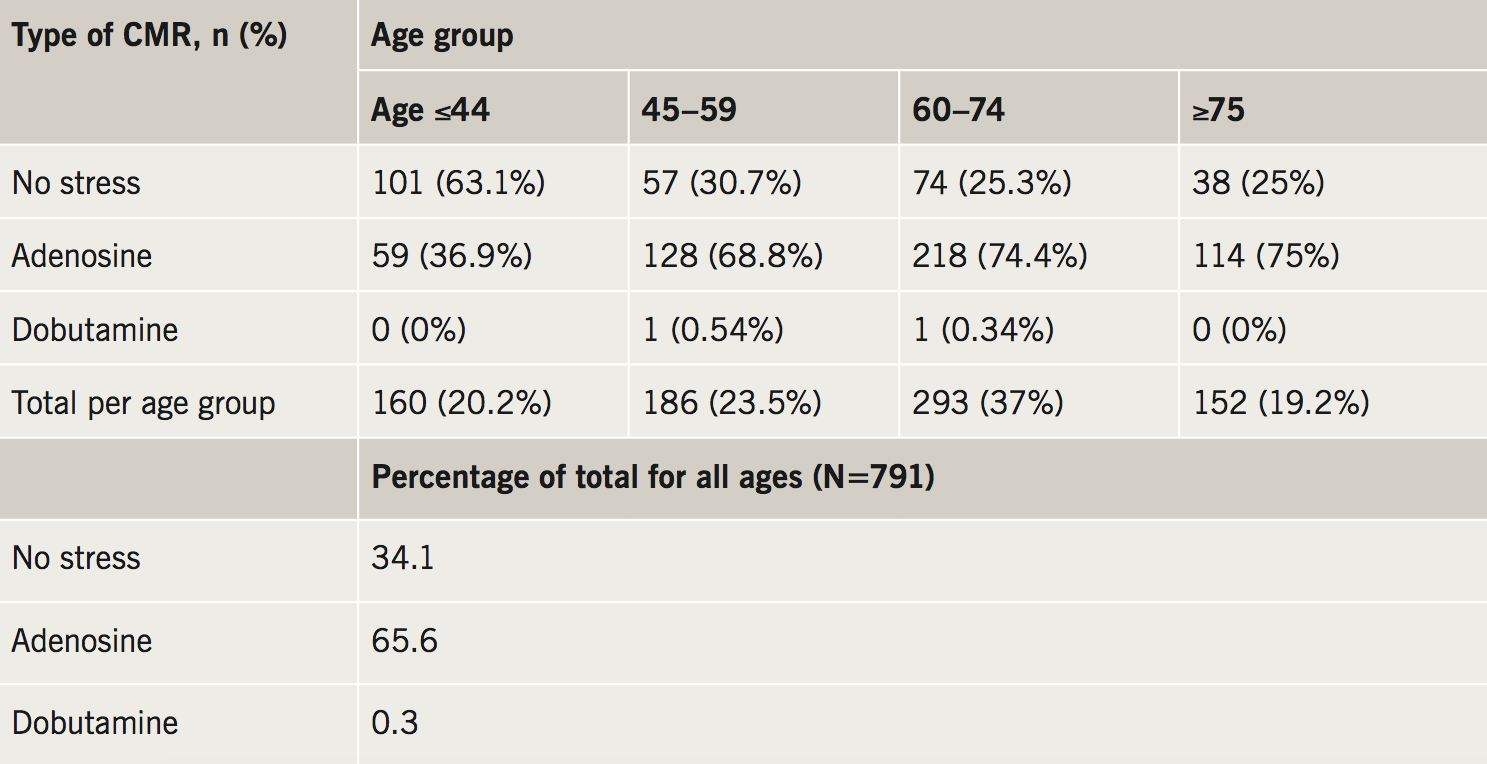
Overall, the procedure was very well tolerated (table 2). Of the total 521 patients undergoing stress perfusion CMR, a total of 20 patients developed mild adverse effects, equating to 3.8%. Of these, eight patients reported feeling anxious and short of breath with the adenosine infusion, but had normal oxygen saturations during and after adenosine infusion. Two patients reported shortness of breath and had a brief transient desaturation, which resolved quickly. Seven patients reported palpitations and shortness of breath with the adenosine infusion. Electrocardiogram (ECG) monitoring revealed no significant arrhythmias in any of these cases and no specific treatment was required. One patient reported nausea temporally related to the administration of Gadolinium contrast and a further patient reported a tension type headache following adenosine infusion. No severe complications were recorded with non-stress or stress CMR. The odds ratio of mild adverse events among stress perfusion patients, occurring in the ≥75 age group compared with the ≤44 age group, was 10.007 (p=0.03).

In non-stress CMR, there were only three patients who experienced mild adverse effects. These three patients reported anxiety type symptoms associated with shortness of breath and normal oxygen saturations.
In both stress and non-stress CMR, no severe complications, such as significant chest pain, arrhythmia or allergic reactions were noted.
Image quality was reported as good quality in 89.3% of cases and moderate quality in 10.6% (table 3). Poor image quality was graded in only one patient. Here, the patient was unable to stay still in the scanner long enough to complete standard image acquisition due to stress urinary incontinence and, as such, the scan was non-diagnostic. The odds ratio of less than good quality image acquisition in the ≥75 age group compared with the ≤44 group was 10.4 (p<0.0001).
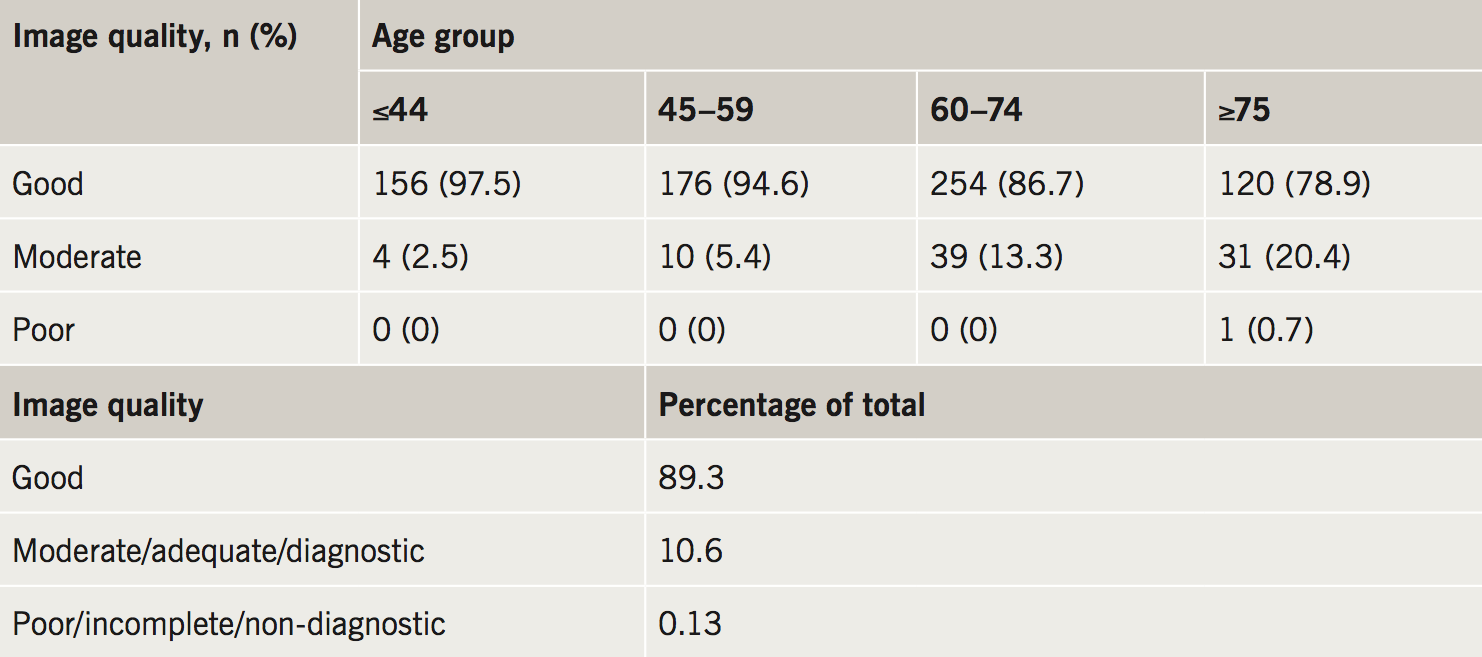
The most common indications for CMR recorded in this study were investigation of cardiomyopathy/myocarditis, investigation of suspected coronary artery disease (CAD) or ischemia testing in known CAD and investigation of myocardial viability to guide revascularisation decisions (table 4).

When broken down into age groups, investigation of cardiomyopathy or myocarditis was most commonly indicated in the ≤44 years age group, investigation of CAD was most commonly indicated in the 45–59 age group, and investigation of myocardial viability was most commonly indicated in the 60–74 age group. In the category recorded as ‘other’, the most common single indication noted was unexplained hypertension in young patients and a CMR was requested to investigate secondary causes.
A therapeutic consequence of the CMR outcome on the patient’s management was recorded if there was a change in medication, the patient went on to have an invasive procedure, or the scan resulted in a patient’s admission or discharge from hospital (table 5). For scans in the 60–74 age group and ≥75 age group, 34.8% and 31.6%, respectively, resulted in at least one of these outcomes. For all ages, at least one of these outcomes was recorded for 26.5% of all scans undertaken underscoring the clinical impact of CMR on the management of patients.

In 18.1% of all the scans, a completely new diagnosis, not suspected before from the patient’s clinical history or previous work up, was identified. Examples include identification of dual pathologies, such as co-existing dilated cardiomyopathy (DCM) with a known history of ischaemic heart disease, a late Gadolinium enhancement (LGE) pattern suggestive of previous infarct with no known history of ischaemic heart disease, and anatomical variants, such as a right-sided thoracic aorta. In addition, patients are sometimes referred with unusual presentations and a cardiac diagnosis is incidentally found. One example of this was a patient admitted to the intensive care unit with recurrent syncope and an unexplained metabolic encephalopathy incidentally found to have hypertensive obstructive cardiomyopathy (HOCM).
From this dataset covering a three-year period, it is estimated that 258 invasive angiograms were avoided due to CMR results. There were 521 patients referred for stress CMR scans overall. Thus 49.5% of results were negative for inducible ischaemia or showed evidence of disease where revascularisation would be unlikely to have prognostic benefit.
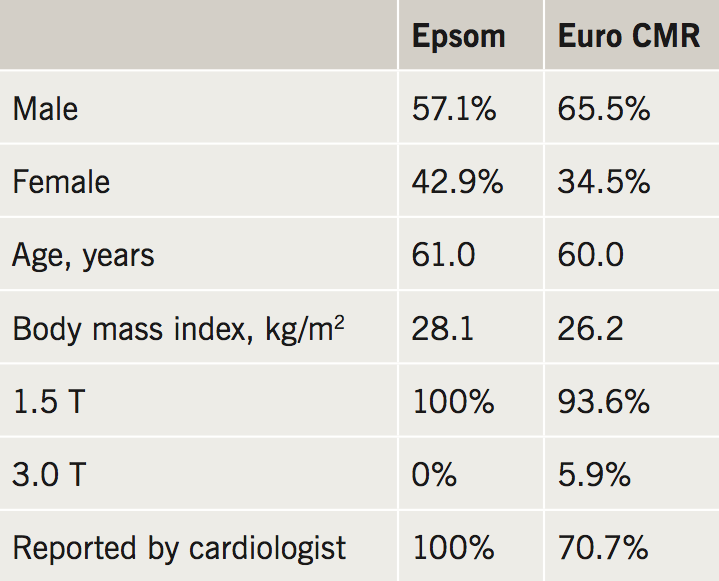
In terms of comparing our database with the published data in the EuroCMR registry, we found that the demographic data of our study population was broadly similar in terms of sex and BMI (see data on file: Appendix B). In our centre, a single consultant cardiologist is responsible for all reporting, whereas other tertiary centres included in the EuroCMR registry may share the workload between cardiologists and radiologists. A small proportion of scans (5.9%) in the EuroCMR registry were undertaken using a 3.0 Tesla magnetic field. A greater proportion of the patients were referred for suspected myocarditis and cardiomyopathy in our centre compared with the EuroCMR data (table 6). The top three indications for both datasets remained cardiomyopathy/myocarditis, suspected CAD and myocardial viability. A greater overall proportion of the scans utilised stress perfusion in the Epsom dataset, even though less patients were being referred for ischaemic heart disease. Despite the higher proportion of stress CMR, the overall incidence of adverse effects and complications was broadly similar between the two datasets (table 7).
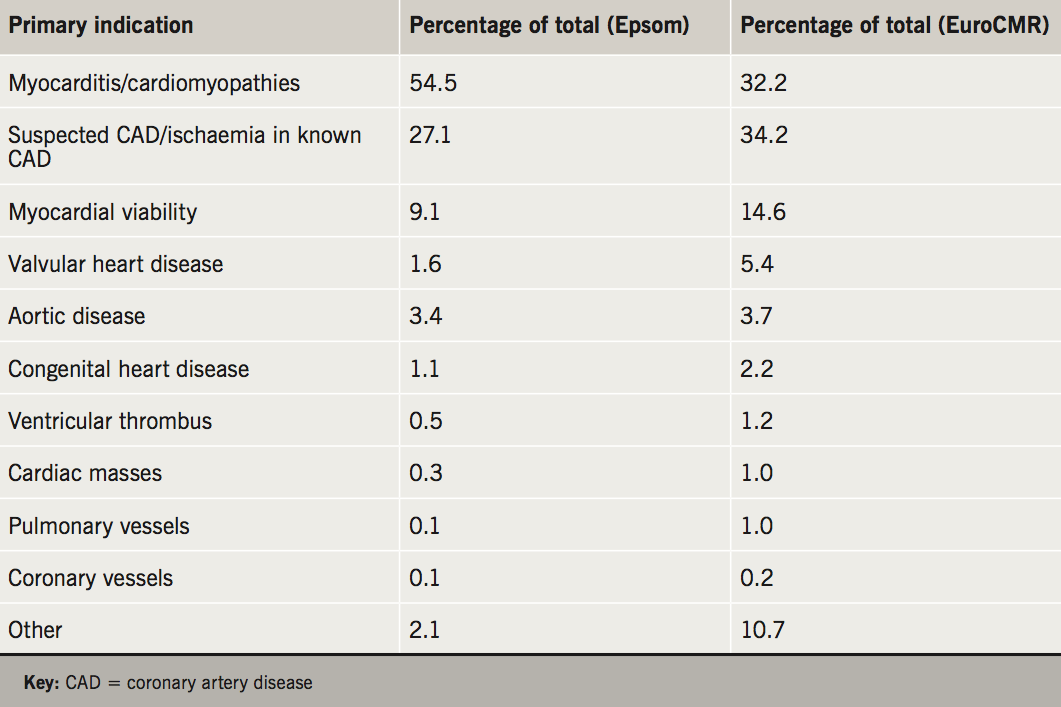

Diagnostic image quality was found in 99.9% of patients in our dataset, comparing favourably with the EuroCMR figure of 98.3%. Suboptimal, but still diagnostic, image quality was associated with more advanced age, and a similar trend was seen in the EuroCMR registry (table 8).

In the Epsom dataset, 26.5% of the total scans resulted in at least one identified therapeutic consequence. In the EuroCMR registry, this figure was 53.4% and some of this discrepancy likely reflects limitations of data collection and access to patient records. The figure of 26.5% also does not account for the proportion of patients for whom the CMR resulted in several consequences, such as a change in medication and also referral for angiogram or surgery, as these would have been recorded as a single therapeutic consequence. It is not clear how the data for patients in this category was handled in the EuroCMR registry. The number of therapeutic consequences is then expressed as the sum of all these singly recorded figures, which may explain why our figure is lower than in the EuroCMR data (table 9).
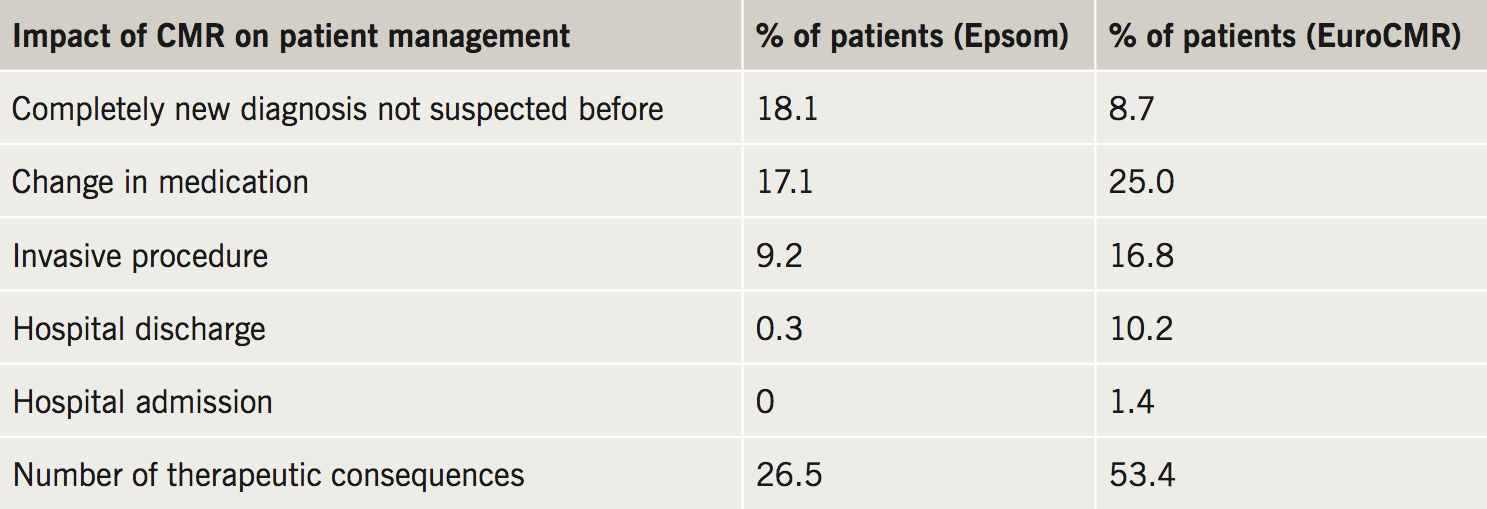
In the Epsom dataset, a completely new diagnosis not suspected before was identified in 18.1% of all patients, compared with only 8.7% in the EuroCMR registry, suggesting an even higher diagnostic value of CMR than previously reported.
Discussion
To our knowledge, this is the first significant CMR database for a DGH population, and it is informative to compare this with the EuroCMR registry data, where the majority of participating centres were tertiary cardiology centres. The British institutions contributing data to the registry were Kings’ College Hospital, St. Thomas’ Hospital and Royal Brompton Hospital from London, and Leeds General Infirmary. Overall, demographic details were similar for both cohorts with a male preponderance (57.1% for Epsom vs. 65.5% in the EuroCMR data), a mean patient age in the seventh decade (61.0 vs. 60.0 years) and a mean patient BMI in the overweight range (28.1 vs. 26.2 kg/m2). In the European study, the most common indication for CMR was in the assessment of ischaemia, whereas in our database, the most common indication was in the assessment of cardiomyopathy and myocarditis. It is perhaps surprising then, that in our study, there was a greater overall proportion of patients referred for stress perfusion CMR. One explanation for this is the reduced accessibility to alternative tests in a DGH, which makes CMR a potential ‘one-stop shop’ where the possibility of significant ischaemia can be excluded, even if the primary indication is something else, such as myocarditis or cardiomyopathy. During the period of data collection, there was limited scope in our centre for patients to undergo immediate inpatient angiography without transfer to a tertiary centre. Whereas patients presenting with a history highly suggestive of myopericarditis in centres with 24-hour cardiac catheterisation facilities may have an immediate or urgent diagnostic angiogram to exclude obstructive coronary disease, and then later, a CMR to confirm the diagnosis, this may not be possible in our study population. Our data suggest CMR may occur first to investigate both differential diagnoses. In addition, waiting list times for alternative non-invasive tests for CAD, such as CTCA (computed tomography coronary angiography), stress echocardiography or myocardial perfusion scintigraphy, may be higher in a DGH, stressing the value of a test that can ‘rule-out’ or ‘rule-in’ multiple diagnoses.
A comparison of the first year of the service with the third year
A subgroup analysis of data collected in 2014, the first year of the new CMR service, and in 2016, the third year of the service, reveals some differences in referral characteristics and outcomes reflecting the increasing uptake of CMR as a diagnostic tool in our region. The three most common indications for CMR were cardiomyopathy/myocarditis, investigation of CAD and assessment of myocardial viability, in that order, in both 2014 and 2016. Together, these referrals constituted 93.0% of the total in 2014, reducing to 90.8% in 2016. The fourth most common indication for referral in 2014 was assessment of aortic disease, making up 5.2% of the total, with referrals for congenital heart disease making up only 0.5%. In 2016, there was a more even spread of ‘unusual’ indications, including investigation of secondary hypertension (2.9%), assessment of valvular heart disease (1.8%) and suspected or follow-up for congenital heart disease (1.5%).
The overall number of scans undertaken in 2014 was 213, and in 2016, this had increased to 340. In 2014, 48.9% of the CMR referrals were from patients followed up in clinic, primarily at Epsom and St. Helier NHS Trust, with other local hospitals and community clinics making up the remainder. By 2016, the proportion of CMR patients followed up at Epsom and St. Helier had increased to 58.2%. The higher volume of scans and referrals from our hospital coincides with the time over which a mobile diagnostic catheter laboratory was set up at Epsom Hospital, meaning that fewer patients had to be referred elsewhere and could have all cardiac investigations locally.
In 2014, 17.4% of scans resulted in a new diagnosis not suspected before from the patient’s background. In 2016, this figure was comparable at 21.5%. Scans resulting in a recognised therapeutic consequence were recorded in 18.3% of CMR patients in 2014 while in 2016, this figure was significantly higher at 33.8%. This suggests that the therapeutic value of CMR increased as the local service expanded. Again, part of this trend may be explained by the local cardiac catheterisation service starting in that time. In addition, it is likely that as the service expanded in terms of total scans undertaken, patients in higher risk groups, more likely to have identifiable pathology, were being scanned.
In 2014, mild adverse effects were recorded in 3.3% of all stress perfusion CMR. In 2016, this figure was 0.88%. Image quality of the scans was recorded as ‘less than good’ (moderate) in 6.6% of all scans in 2014. In 2016, image quality of ‘less than good’ (moderate or poor) was recorded in 14.7%. These figures are harder to interpret given the inter-individual variability in application of the grading criteria among the investigators, and in retrospect, the relatively less strict definition of ‘mild’ adverse effects and ‘moderate’ image quality used in our methods. For example, mild symptoms of shortness of breath and palpitations may be difficult to delineate from anxiety and claustrophobia, rather than a physiological effect of the CMR and infused drugs, and this may have resulted in discrepancies in the data.
Safety and image quality of CMR
Across the 791 patients in our study population, no allergic reactions, significant arrhythmias, ACS or heart failure events were recorded. Adverse effects seen in our study were mainly palpitations and shortness of breath, which was positively associated with increasing age. The odds ratio of mild adverse events among stress perfusion patients, occurring in the ≥75 group compared with the ≤44 group was 10.0070 (p=0.03). This association was not detected in the EuroCMR study, but makes intuitive sense as older patients with advanced comorbidities would be more likely to report dyspneoa and chest pain with infusion of adenosine.4 An overall mild adverse event rate of 3.8% in stress CMR and 1.1% in non-stress CMR reiterates that the procedure is well tolerated in the vast majority. Despite the caveats noted above regarding reporting of mild adverse events, our figures were similar to the EuroCMR data (table 7).
Diagnostic image quality was found in 99.9% of patients. Suboptimal, but still diagnostic, image quality was associated with more advanced age with a similar trend seen in the EuroCMR registry (table 8). The odds ratio of less than good quality image acquisition in the ≥75 age group compared with the ≤44 age group was 10.4 (p<0.0001). Many of the patient factors that cause breathing or cardiac motion artefact, the key limitations to CMR image acquisition, are associated with advanced age. These include an impaired ability to follow instructions, for example through cognitive or hearing impairment, inability to breath-hold for the desired time and a greater incidence of arrhythmias, such as atrial fibrillation.
Conclusion
This dataset of 791 patients undergoing CMR in a DGH setting shows that the most common indications for scanning are work-up for cardiomyopathy/myocarditis, investigation of suspected CAD and myocardial viability testing. Compared with the EuroCMR registry data, which mainly included tertiary cardiology centres, a greater proportion of patients are referred for investigation of cardiomyopathy and undergo stress perfusion CMR, which likely reflects differences in the service provision of cardiology investigations between these study populations. Overall, the procedure is well tolerated and safe, with only 3.8% experiencing mild adverse effects in stress perfusion CMR and 1.1% in non-stress CMR. No serious adverse effects were recorded in this study population. Image quality was diagnostic in almost all cases: 99.9%. The CMR outcome results in changes in the patient management in over a quarter of patients (26.5%). CMR detects completely new diagnoses not suspected before in nearly a fifth of patients (18.1%), which is a higher figure than reported in the multi-national EuroCMR registry data.
Conflict of interest
None declared.
Key messages
- Cardiac magnetic resonance imaging (CMR) is a well-tolerated procedure with a very low incidence of adverse effects and high rates of diagnostic accuracy
- The most important indications for CMR are the diagnosis of myocarditis and cardiomyopathies, investigation of an ischaemic cause of chest pain and myocardial viability testing
- In nearly 18.1% of cases, CMR identifies a diagnosis not clinically suspected before the test, and in 26.5% leads to changes in the patient’s management
References
1. Bruder O, Wagner A, Lombardi M et al. European cardiovascular magnetic resonance (EuroCMR) registry – multi-national results from 57 centers in 15 countries. J Cardiovasc Magn Reson 2013;15:9. https://doi.org/10.1186/1532-429X-15-9
2. Bruder O, Schneider S, Nothnagel D et al. EuroCMR (European cardiovascular magnetic resonance) registry: results of the German pilot phase. J Am Coll Cardiol 2009;54:1457–66. https://doi.org/10.1016/j.jacc.2009.07.003
3. Altman DG. Practical Statistics for Medical Research. London: Chapman and Hall, 1991.
4. Karamitsos TD, Arnold JR, Pegg TJ. Tolerance and safety of adenosine stress perfusion cardiovascular magnetic resonance imaging in patients with severe coronary artery disease. Int J Cardiovasc Imaging 2009;25:277–83. https://doi.org/10.1007/s10554-008-9392-3
